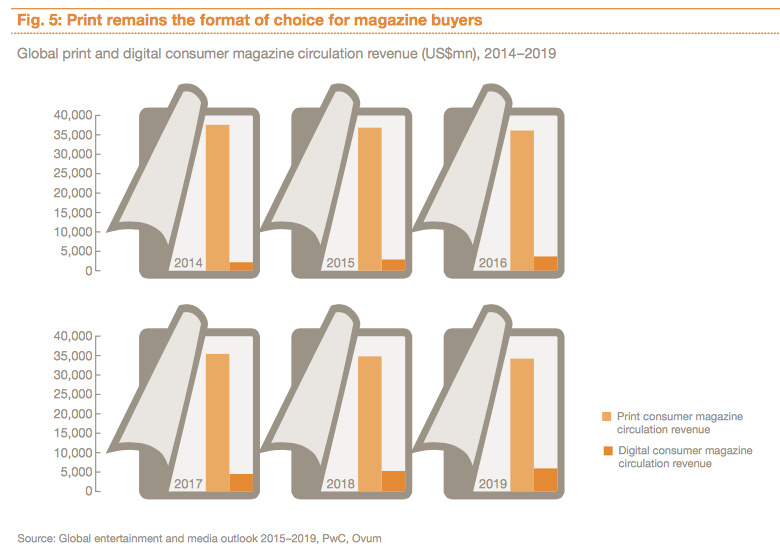Digital magazine adoption has been slow in coming. And according to the latest figures from PricewaterhouseCooper, “it’s still far from becoming the central pillar of magazine media,” notes Michael Rondon in Folio:.
“Overall, the industry is rebounding from several years of declines, and is expected to increase total global revenue in each of the next five years, topping out at $97.42 billion in 2019, up from $95.33 billion last year. Now in its 16th year, the report provides a five-year forecast based on advertiser and consumer spending data and commentary,” Rondon notes.
The news is good overall for the magazine industry: revenue will continue to climb, led by a solid B2B climate, and is expected to be back near 2010 levels within the next four years.
Among the key findings of PWC’s annual Global Entertainment and Media Outlook:
 Magazine revenue will continue up – “Driven by a 1.5% CAGR growth in trade magazine revenue, global total magazine revenue will reach US$97.42bn in 2019, up from US$95.33bn in 2014, but growth will be no higher than 0.55% in any year of the forecast period,” notes PRC’s website, adding that a growing middle class in emerging economies like India and Mexico will drive consumer magazine revenue.
Magazine revenue will continue up – “Driven by a 1.5% CAGR growth in trade magazine revenue, global total magazine revenue will reach US$97.42bn in 2019, up from US$95.33bn in 2014, but growth will be no higher than 0.55% in any year of the forecast period,” notes PRC’s website, adding that a growing middle class in emerging economies like India and Mexico will drive consumer magazine revenue.
Digital editions “don’t matter” – “Consumer magazines get almost all their circulation revenue from print, and that’s not about to change,” writes Rondon. “Even as the world gets inundated with devices—PwC forecasts that smartphone ownership will double by 2019—digital editions will still only generate a small fraction of what print does.”
While total print consumer circulation is expected to decline over the next five years, print will still dominate the market with an estimated 85.2% of readership.
Digital strategies will continue to drive revenue to the publisher outside of digital magazine editions (events, ticket sales, subscriptions, magazine websites, etc.), a trend we’ve noted before, but digital editions will continue their decline.
“Digital magazine subscriptions will not benefit from increasing digital access, with magazine websites instead receiving increased views,” the report notes.
